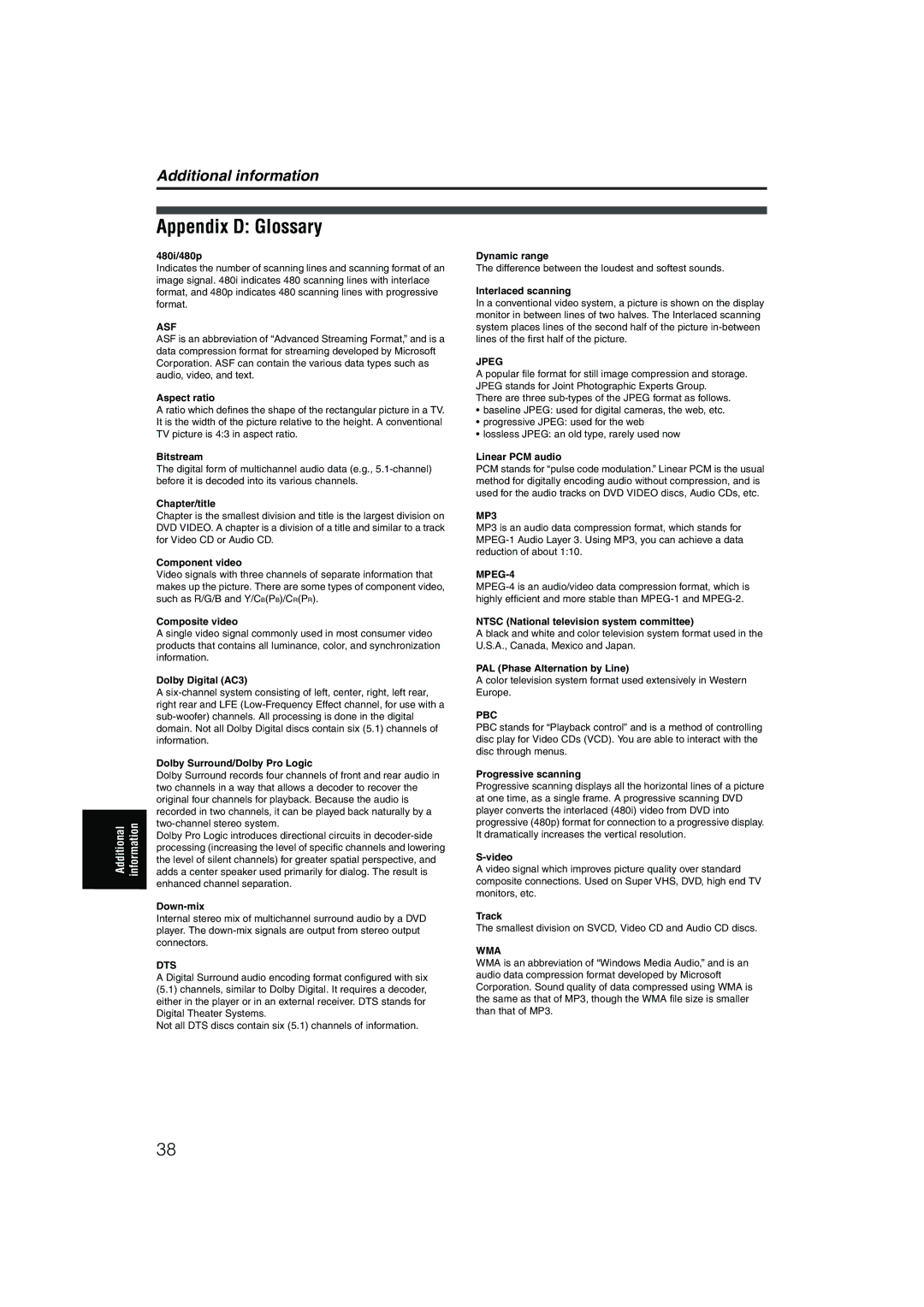
Additional information
Additional | information |
Appendix D: Glossary
480i/480p
Indicates the number of scanning lines and scanning format of an image signal. 480i indicates 480 scanning lines with interlace format, and 480p indicates 480 scanning lines with progressive format.
ASF
ASF is an abbreviation of “Advanced Streaming Format,” and is a data compression format for streaming developed by Microsoft Corporation. ASF can contain the various data types such as audio, video, and text.
Aspect ratio
A ratio which defines the shape of the rectangular picture in a TV. It is the width of the picture relative to the height. A conventional TV picture is 4:3 in aspect ratio.
Bitstream
The digital form of multichannel audio data (e.g.,
Chapter/title
Chapter is the smallest division and title is the largest division on DVD VIDEO. A chapter is a division of a title and similar to a track for Video CD or Audio CD.
Component video
Video signals with three channels of separate information that makes up the picture. There are some types of component video, such as R/G/B and Y/CB(PB)/CR(PR).
Composite video
A single video signal commonly used in most consumer video products that contains all luminance, color, and synchronization information.
Dolby Digital (AC3)
A
Dolby Surround/Dolby Pro Logic
Dolby Surround records four channels of front and rear audio in two channels in a way that allows a decoder to recover the original four channels for playback. Because the audio is recorded in two channels, it can be played back naturally by a
Dolby Pro Logic introduces directional circuits in
Down-mix
Internal stereo mix of multichannel surround audio by a DVD player. The
DTS
A Digital Surround audio encoding format configured with six (5.1) channels, similar to Dolby Digital. It requires a decoder, either in the player or in an external receiver. DTS stands for Digital Theater Systems.
Not all DTS discs contain six (5.1) channels of information.
Dynamic range
The difference between the loudest and softest sounds.
Interlaced scanning
In a conventional video system, a picture is shown on the display monitor in between lines of two halves. The Interlaced scanning system places lines of the second half of the picture
JPEG
A popular file format for still image compression and storage. JPEG stands for Joint Photographic Experts Group.
There are three
•baseline JPEG: used for digital cameras, the web, etc.
•progressive JPEG: used for the web
•lossless JPEG: an old type, rarely used now
Linear PCM audio
PCM stands for “pulse code modulation.” Linear PCM is the usual method for digitally encoding audio without compression, and is used for the audio tracks on DVD VIDEO discs, Audio CDs, etc.
MP3
MP3 is an audio data compression format, which stands for
MPEG-4
NTSC (National television system committee)
A black and white and color television system format used in the U.S.A., Canada, Mexico and Japan.
PAL (Phase Alternation by Line)
A color television system format used extensively in Western Europe.
PBC
PBC stands for “Playback control” and is a method of controlling disc play for Video CDs (VCD). You are able to interact with the disc through menus.
Progressive scanning
Progressive scanning displays all the horizontal lines of a picture at one time, as a single frame. A progressive scanning DVD player converts the interlaced (480i) video from DVD into progressive (480p) format for connection to a progressive display. It dramatically increases the vertical resolution.
S-video
A video signal which improves picture quality over standard composite connections. Used on Super VHS, DVD, high end TV monitors, etc.
Track
The smallest division on SVCD, Video CD and Audio CD discs.
WMA
WMA is an abbreviation of “Windows Media Audio,” and is an audio data compression format developed by Microsoft Corporation. Sound quality of data compressed using WMA is the same as that of MP3, though the WMA file size is smaller than that of MP3.
38
